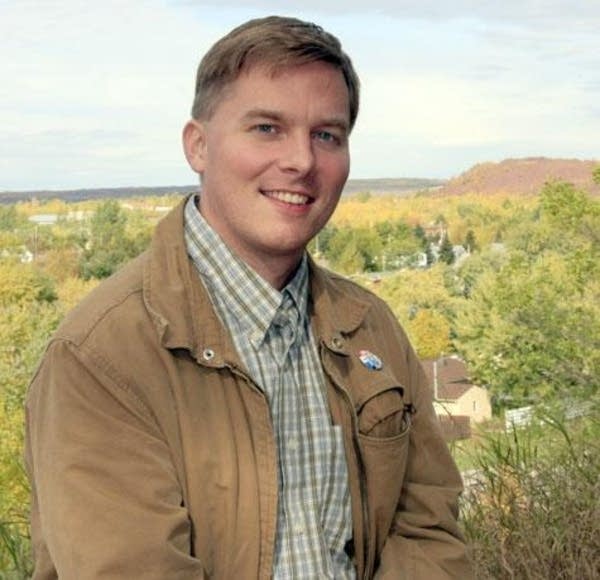Awkward hugs can't save northern Minnesota

Aaron J. Brown is a writer and community college instructor from the Iron Range. He is the author of the blogMinnesotaBrown.com and host of the Great Northern Radio Show on 91.7 KAXE.
St. Louis County, which contains much of Minnesota's Iron Range region, is trying out a new marketing campaign: "Hug a Ranger."
Let me break this down for the city folk. We still mine here. Did you know that? That mining produces minerals you use, and the revenue generated benefits both local communities and the state through land grants and resource funds. You should thank miners. No, more than that. You should hug them. That's the premise of "Hug a Ranger."
I've got two problems. One, I hate hugging. Especially stranger hugging. Pretty girl hugging is nice, but still awkward for me. And I'm married, so really I could divest myself of the whole enterprise. I don't think this is much different for most Iron Rangers, particularly those in the trades.
Create a More Connected Minnesota
MPR News is your trusted resource for the news you need. With your support, MPR News brings accessible, courageous journalism and authentic conversation to everyone - free of paywalls and barriers. Your gift makes a difference.
That brings me to my second problem. If you were to drive to St. Louis County and hug someone at random, there is only a tiny chance that person would work in the mines or in a supporting industry. In Duluth, you might only have a chance at Gander Mountain or maybe the hospitals. Even if you drove up to the Iron Range, you'd still have about a 1 in 25 chance of hugging a miner on the first try.
If you hugged a random person in the heart of the Mesabi you'd probably hug A) a service worker making minimum wage or near that, or B) a retiree on a fixed income wondering why property taxes keep rising on a $38,000 house. They might be more likely to hug back than a miner, but only because those folks need hugs. A modern mining job puts you well above the median income on today's Iron Range. Granted, mining isn't easy, but when the mines are running it's the rest of the population that struggles to get by.
Naturally, all of the mine production discussed in this "Hug a Ranger" material comes from iron mining, where the taconite industry is indeed running strong. But this campaign wouldn't be a proper reflection of local politics if it weren't instead a breathless, fawning campaign ad for nonferrous mineral mining, the more controversial proposed mining northeast of the iron formation, near Ely and the Boundary Waters. At one point in the brochure, the text says this:
"New, nonferrous projects in Minnesota have the potential to add more than $2.7 billion to the state's economy and another 7,000 new jobs by 2013."
A county official later admitted that the brochure contained a typo, and that the promised 7,000 new jobs would materialize by 2030, not 2013. Even so, the number seems optimistic. Polymet, the most stable and established of the proposed mining companies, projects a 10th of that, at most.
Yes, hundreds of jobs are good. But they will not create a vibrant economy that generates enough other jobs to navigate the inevitable slides in commodity prices that always send the Range economy through booms and busts. Leaders in the area continue to put all chips on one spoke of the roulette wheel, at the expense of economic diversification.
I've said several times that the Range will need a marketing campaign to sell itself as a destination for families, professionals and businesses. Some reforms are needed along the way, however, among them a reform in the attitude that produces bloated, parochial, self-congratulatory marketing campaigns to mask unfettered dependence on mining. My wish list also includes municipal reforms, school investment and curriculum reforms and a renewed focus on making our communities livable. If we did these things, maybe we could run a campaign like this:
"Here on the Iron Range, things are moving. For more than 100 years an immigrant people has moved the earth to extract the ores that forged great cities, won both world wars and continue to build America.
"Today we mine minerals, knowledge, innovation and the arts in one of the nation's safest, most affordable places. Our three world-class technical high schools, arts magnet school and 20 award-winning elementary schools don't just compete with other small towns; their small class sizes and skilled teachers prepare students to compete in a global economy, with skills to succeed both academically and in technical career fields.
"We offer two-year, four-year and advanced college degrees and low-interest financing for new entrepreneurs and artists. Our mineral resources give us the lowest property taxes in the state. Our high-speedIinternet system makes the world our marketplace. The unique culture of our native and immigrant population continues to grow with galleries, public art, freelance support programs, film and theater companies. A fifth of Minnesota's famed 10,000 lakes and most of its public recreation lands are just a short drive from our towns.
"If you haven't seen today's Iron Range, you should. But don't expect to sit around. On the Iron Range, things are moving."
The problem with this message now is that it just isn't true. Not yet. If I ever seem frustrated about the state of things on the Iron Range it is because we could do this — but we aren't doing it, at least not fast enough to avoid the next bump in the region's rocky economic road.
By all means, hug a Ranger. See if that works. When you're finished, let's do the hard work to make a better future for the Iron Range. This region really does offer much to the entire state, and it will need people from all over the place to succeed.
